
SHAH ALAM: Another AW139 for Op Benteng. Back in July last year, the Defence Ministry issued a tender to lease two helicopters for the RMN as part of Op Benteng operations. I did a story on that tender but it appears that the tender was subsequently cancelled.
Now it appears that at least one aircraft is likely to be operated by the National Task Force (NTF) the body set up to coordinate the various agencies involved in Op Benteng.
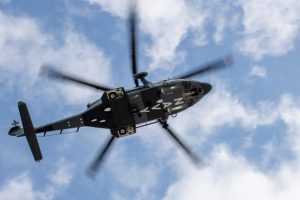
The NTF operated helicopter, an AW139, appeared in a banner (main picture) at the Defence Ministry booth at the Keluarga Malaysia exhibition held in conjunction with the 100 day celebration of the current government. The banner said AW139 GOCOM, which may mean Government Owned, Company Operated and Managed.
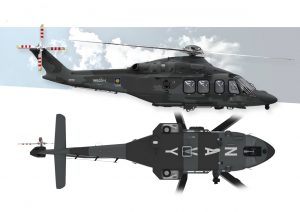
It must be noted that there is a single government owned AW139 -serial number 9M-JPM – which arrived here a few months back. It is bought for the Prime Minister’s Department hence the serial number JPM – Jabatan Perdana Menteri. I managed to track its movement on an aircraft tracking application likely in September though I have not seen the aircraft on it anymore. It is very that 9M-JPM is the helicopter to be used by the NTF.
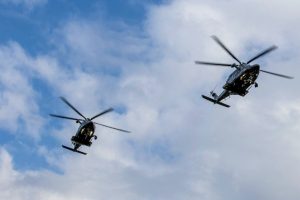
It is also likely that 9M-JPM would be flown by Galaxy Aerospace flight crews which will also provide the maintenance at its facility in Subang hence the GOCOM designation. NTF personnel will be onboard to conduct the surveillance operations. This is a slight variation to the canceled helicopter leasing programme which was supposed to be company owned, company operate and managed, with the surveillance personnel coming from the navy.
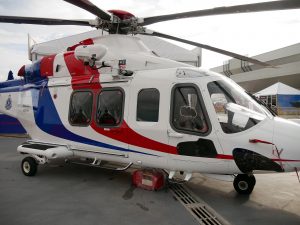
Meanwhile in Parliament, yesterday, Deputy Defence Minister DS Ikmal Hisham Abdul Aziz stated that the MD-530G helicopters will be delivered in the first quarter of next year. The helicopters are likely to be delivered later than the RMN Maritime Utility Helicopters as suggested previously.
HT to DM.
— Malaysian Defence
If you like this post, buy me an espresso. Paypal Payment

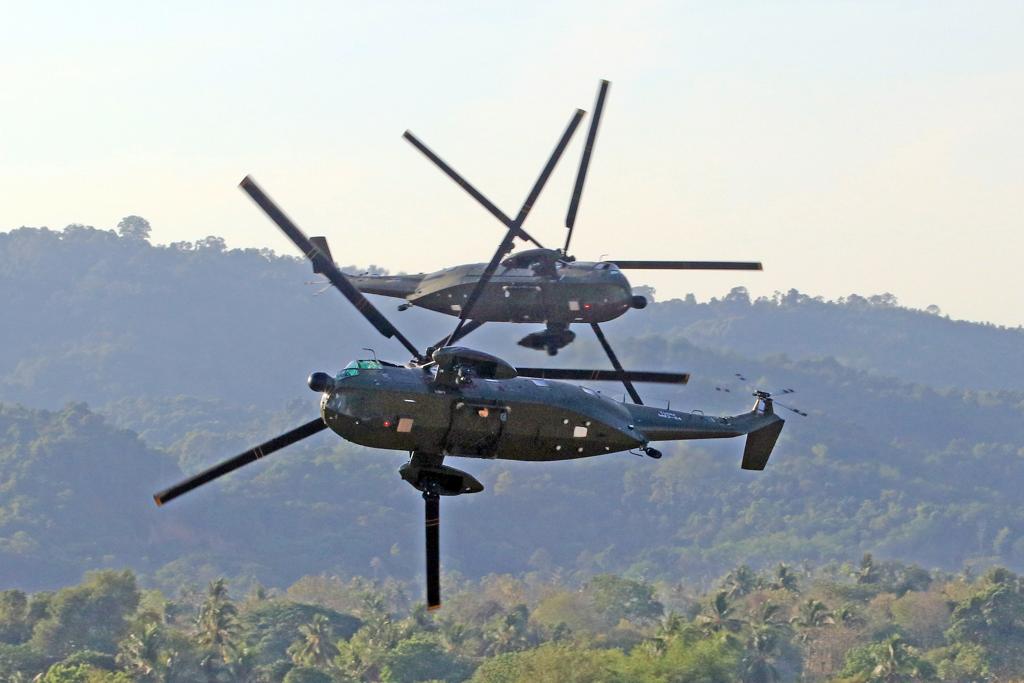
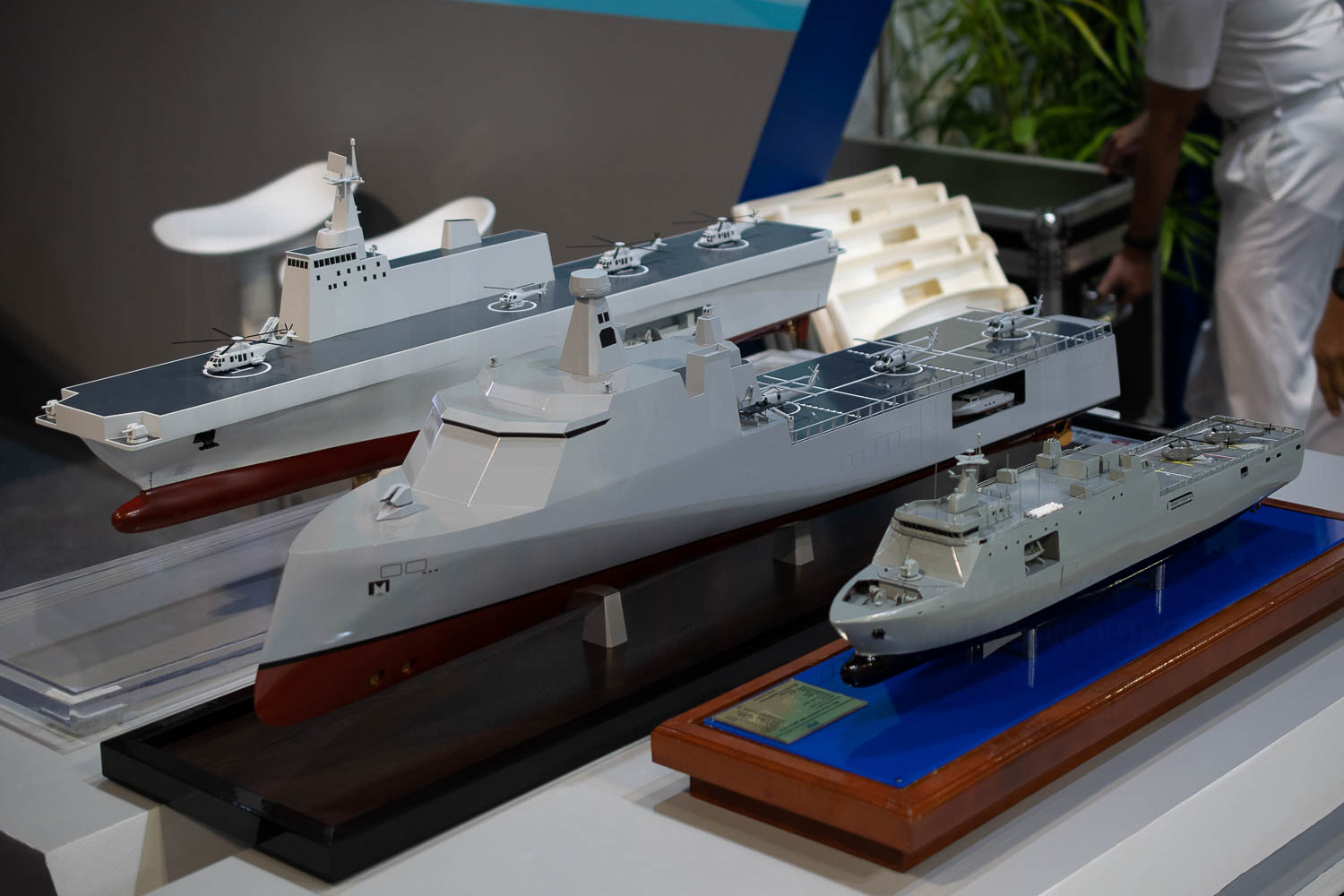
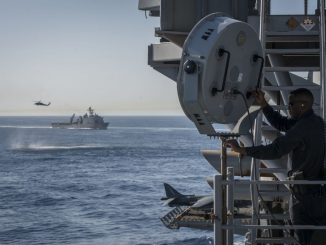
So that chopper under RMN or RMAF?
Marhalim, the latest news this morning is the Australian Army will be replacing the Taipans with Blackhawks because of reliability and maintenance issues. Could they be any use to us, not for the army/military but for more civilians type applications? Perhaps maybe?
Unlikely for us, as even Oz apparently cannot afford them
its under NTF
Oh yeah great another postponement for that mere 6 md530g..Bought in 2016 mind you..What a joke..
Tom Tom – ”Could they be any use to us, not for the army/military but for more civilians type applications? Perhaps maybe?”
First determine why Australia and other users are having issues with their NH-90s and then ask yourself if these issues will be a major concern for us ,,,,
Those NH-90 / MRH-90 is a perfect example of something used, will be available but we should avoid at all costs.
So it all depends, things like Legacy Hornets yes as we are adding to something we already currently using. But things like those MRH-90 with high operating costs and questionable reliability, a big no.
gonggok – “things like those MRH-90 with high operating costs”
Indeed. The Australians are on record as saying that it’s more expensive to run compared to a Blackhawk and we know the Blackhawk is more expensive to run compared to a Cougar, gives us some idea of the costs involved.
gonggok – “Legacy Hornets yes as we are adding to something we already currently using”
But which are already 30 odd years and getting older and will require more post flight maintenance hours as they aged further in RMAF service equating to extra costs and resources. Pros and cons. As it stands we are on a shoe string budget operating and maintaining what little we have and can’t even afford a AESA radar for the 8 Ds we have. By right we also should be seriously contemplating an upgrade for the MKMs to improve capabilities and replace expired/obsolete components which were designed in the 1990’s.
@gonggok
The idea of going for used ones is, they already would have a known track record of usage, hence reliability is a known factor as compared to newer stuff that has less users. So if you known a used KIA model has given problems when new, obviously buying it used is tempting fate rather than a used Toyota. The same applies, however it’d depends. Reselling to current NH90 users would make sense as they would know its faults and best ways of tackling them (with the OEM). Some of the issues were unsurmountable bcoz OZ requirements differ from NATO’s (which that chopper was purposely designed to meet).
Back to the AW139, I’m all for a homogenous model used for the various Forces requirements, so it would be good if the AW139 (or the bigger 149 variant) could be used to fulfill TLDM ASW role.
The AW139 is roughly the same weight category as a Wildcat so whether it has the range, endurance, internal volume/space and lift capacity to carry the crew; a full load of fuel; a dipping sonar and associated equipment; a pair of torps and sonobuoys is the question.
Also whether the AW139 or 149 there are no current ASW users foe either type; so we’d be the first and would have to pay integration/certification costs for all the needed stuff. Another question; I know the AW139 has been ordered by the RMN but is it actually fully marinised?
Azlan – “the Blackhawk is more expensive to run compared to a Cougar”
flight cost per hour of the cougar, blackhawk and nuri are in the range of 4,200 dollars give or take a few hundred.
AW139 around 3,000 dollars.
MD530 around 1,100 dollars.
a highly upgraded but old UH-1H+ flying cost is just about 2,000 dollars an hour. which is why they are still being flown and upgraded.
I’m well fully aware we’d be the first implementer for the ASW version if we pursue that, but current purpose built ASW choppers are much too expensive or too big to fit into our ship borne hangars, so its either that or “a ASW helo does not have the range and endurance to get to where it has to and to stay there for a while to locate a target and to engage it and can’t carry torps, sonobuoys and a dipping sonar, then it’s not up to the task.”
Also AW139 are being used by Japan CG, Italian CG, Algerian Navy, Nigerian Navy, Dutch Carib CG, SASEMAR, Swede MRG, UK CG, our MMEA of course, and plenty of civvie offshore contractors. So the question if they can be fully marinised is moot.
gonggok,
I”m not disputing those figures but they provide an indicatiom and are not representative of actual prices because of certain variables.
Take the Nuri, its costs will be due not only to fuel but also the increasing number of post flight hours it requires plus the more regular checks required on various things due to age, a reason the RMAF retired it.
A Cougar on the other hand may be a smaller helicopter and has more fuel efficent engines but it has a higher level of automation/electronics all of which need servicing and test/support equipment, adding to costs. On the Blackhawk years ago I asked around [when the news of the Brunei ones appeared] and was told my 2 knowledgeable sources that its per hour operating costs was higher than the Cougar.
From aussie sources, MRH-90 flying costs has increased from 30,000 to 50,000 aussie dollars per hour. That is like flying costs of a Sukhoi MKM rather than a helicopter. A no brainer to switch back to blackhawks, as just the savings of flying costs itself would pay for those new blackhawks.
Azlan – “we also should be seriously contemplating an upgrade for the MKMs”
Our MKM are fitted with some of the most cutting edge equipments that is available in 2010. The Rhode & Schwarz Software defined radios is still one of the most advanced there is even right now. The Damocles targeting pod is 1 generation ahead of the ATFLIR on the Hornets, even if there is the TALIOS replacing it. For example Saudi Typhoons and tornados is still using Damocles too. The KNIRTI SAP-518 digital jamming pods is also one of the most advanced at the time, which one of a reason why USN now is developing brand new jamming pods for their growlers.
Upgrading MKM would be needed in 10 years time, the constraints is if we have enough budget to upgrade the MKM and buy a new 5th gen MRCA at the same time.
Azlan – “I know the AW139 has been ordered by the RMN but is it actually fully marinised?”
AW139 is designed for offshore Oil and Gas operations. As is the EC225. But still the aircraft needs to undergo stringent corrosion prevention plan as part of its daily maintenance to maintain its corrosion proofness.
Azlan – “a reason the RMAF retired it”
RMAF did not retire the nuri because of flying hours cost, but due to specific components no longer airworthy that caused the groundings, which actually can still be sourced used if they want.
I will put up the specific flying hours cost + fuel consumption. All the variables are the same as these numbers are from 1 single source data point (ie not from different documents).
Cougar/EC225 – $4,242/hr , 183gal/hr
UH-60 blackhawk – $4,280/hr , 160gal/hr
S-61 Nuri – $4,544/hr , 170gal/hr
The nuri cost is including all the additional maintenance costs due to age, which is more than newer blackhawk and cougar. But if you consider the nuri has long being paid for and the saving of not having to buy new helicopters, is a very minor increase in operating cost.
Azlan – “A Cougar on the other hand may be a smaller helicopter (than the nuri)”
Sorry, but the EC725 cougar and nuri is similarly sized. The blackhawk is smaller sized than both, but all 3 are 10 ton max takeoff weight helicopters.
AW139 is a smaller helicopter compared to all 3, and has about 6.5-7 ton max takeoff weight.
Lynx has about 5.3 tons max takeoff weight, while the Dauphin about 4.5 tons.
Joe – “current purpose built ASW choppers are much too expensive or too big to fit into our ship borne hangars”
RMN gowinds are designed to fit 10 ton helicopters, one of the reason it is longer than normal gowinds. So anything smaller than Cougar/blackhawks will fit. There is no guarantee that a custom built AW129 ASW helicopter will be cheaper than the SH-60R Romeo. Usually 80% of ASW helicopter cost is the ASW stuff. Which is why a normal blackhawk is 15-20 million dollars while the romeo seahawk is 100 million dollars.
– ”I’m well fully aware we’d be the first implementer for the ASW version if we pursue that”
Well I’m glad that you’re aware. Gratifies me truly. If the AW139 requires integration/certification to be used as a ASW helo and if it does not offer much in terms of range, endurance, lift capacity and other things compared to Wildcat; we’d be better off going for Wildcat even with its inherent limitations as a ASW platform.
– ”So the question if they can be fully marinised is moot.”
Well many thanks to you. If I have known the answer or if it was ”moot”’ I wouldn’t have asked the question now would I?? Ta again anyway.
– ”or too big to fit into our ship borne hangars”
On Merlin is too large to fit in our hangars and Merlin was never even considered; thus the point is ”moot” …….
gonggok – ”Our MKM are fitted with some of the most cutting edge equipments that is available in 2010.”
Put things in perspective; the gear was designed mostly in the 1990’s…. They were great up to the mid 2000’s but’s it’s 2021 now.
gonggok – ”The Damocles targeting pod is 1 generation ahead of the ATFLIR on the Hornets”
How on earth did you reach that conclusion? First of all Damocles is not a full navigation/targeting pod. Secondly it has various limitations with regards to height and other areas compared to other navigation/targeting pod; which is why for the French it was only an interim solution and why it was offered for export first for select customers who did or could not get Lighning or a U.S. pod. Do ask around.
Also; why the RMAF as far back as a few years ago was already looking at a Damocles replacement and ask any pilot which he prefers : Damocles or ATFLIR; in terms of having a full targeting/navigation capability and performance of the actual sensors.
gonggok – ” The KNIRTI SAP-518 digital jamming pods is also one of the most advanced at the time,”
”For it’s time” is the keyword. Problem is we’re in 2021 now and EW [almost more than anything else] requires constant upgrades. Has it received software upgrades? How effective is it against the seeker of latest gen AAMs?
gonggok – ”Upgrading MKM would be needed in 10 years time,”
Incorrect’ it’s needed way before that which is why years ago the RMAF already did a feasibility study. 10 years for now a lot of the 1990’s components on the MKM will no longer be supportable ….
gonggok = ”which one of a reason why USN now is developing brand new jamming pods for their growlers.
– The pod on the MKM is to deal with the active seekers of SARH AAMS.
– The pods on Growlers are intended to deal with primary radars or FCSs of GBADs. 2 different things …..
gonggok – ”The Rhode & Schwarz Software defined radios is still one of the most advanced there is even right now.”
”Advanced” is such an overused cliche that I don’t really know what it means anymore. It is a great radio; one of the best cash can buy but many other radios are also ”advanced” and the ones on the MKMs are close to 2 decades old now and were designed much earlier; thus they will have to be replaced in the coming years; just like various other things on the MKMs which are getting aged and were first designed in the late 1990’s.
gonggok – ‘RMAF did not retire the nuri because of flying hours cost”
The RMAF retired the Nuri because spares were getting harder to source, it was requiring more post flight maintenance hours [leads to more costs] and various things were breaking down more often due to age.
gonggok – “Sorry, but the EC725 cougar and nuri is similarly sized”
“Sorry” that may be so but Cougar has more fuel efficient engines and it has newer systems which make it in a sense cheaper and less maintenance intensive to fly and maintain compared to the Nuri but because it is fitted with more electronics and automation this presents a diffrent set of challenges to maintain.
Gonggok – “AW139 is a smaller helicopter compared to all 3,
Thank you, which is why I questioned whether it has what it takes to be a ASW configured platform and that we’d be better off going for Widcat which is already certfied for ASW despite inherent limitations.
gonggok – “There is no guarantee that a custom built AW129 ASW helicopter will be cheaper than the SH-60R.”
And
interastion/certification can go as high as 25 percent of the overall costs and it does not make sense to do so given the small numbers we’ll buy. Together with limitations of the AW139, it will be an exercise in toomfoolery if we get the type for ASW.
gonggok – ” is a very minor increase in operating cost”
It is not minor if servicibility rates are affected and extra hours are needed for maintenance. Which is why after examing various factors and looking at the resources it has the RMAF felt that upgrading the fleet [which it wanted for a long time] was no longer a sound return of investment. Yes for reasons given the Nuri is more maintenance intensive [which equates with more costs] than a newer Cougar. As for costs on paper, there are variables. It gives a rough guide but the actual costs will depend.
gonggok – “aircraft needs to undergo stringent corrosion plan”
The CNs had corrosion issues because of deloyments to Layang-Layang and the Lynxs had issues during during Ops Fajar. AAC Apaches also had issues when deployed on Ocean.
By right each aircraft has to be hosed down immediately after a sortie and a number of checks have to be done. Failure to do that leads to issues after a certain period.
@gonggok
“RMN gowinds are designed to fit 10 ton helicopters”
Based on open sourced, Gowind hangar fits a medium sized chopper (assuming it means a Seahawk sized chopper). I’m not aware if the hangar have been enlarged vs ori Gowind. But considering that a Romeo @20mtr long could fold its tail & blades, anything larger would not fit into the hangar.
“no guarantee will be cheaper than the SH-60R Romeo”
The Romeo is the Apex of ASW chopper, and fitted with all the bells & whistles. There are many lesser kitted ones (see TLDM Lynx) but still could do the main job of ASW with certain limitations. Not ideal but imho something in the range of 7-9t ASW chopper at <19mtr dimensions would suit our needs. If we could standardize the fleet to use Airbus then only AW139/149 fits the bill. A Cougar/Wildcat sized would not fit a certain someone's idea of an ASW chopper.
About the Nuris, AFAIK one main reason for the retirement is their inability to fly at night, and retrofitting for night flying capability is not cost efficientwise for TUDM (or rather it is an opportunity to justify getting out of 'hauling the Army business').
A major problem of the Nuri is not their inability to fly at night [several were had NVG compatible cockpits] but the fact they only could fly in VFR. Another issue is only a few were fitted with an auto hover [renemember Mukah Head?].
Ultimately the main reason they were retired is because they were getting increasingly maintenance intensive [and expensive] to run on account of age and it was felt that it just was not worth to upgrade them.
” A Cougar/Wildcat sized would not fit a certain someone’s idea of an ASW chopper.
”
Get the narrative right at least. A Wildcat would not fit various navies idea of a ASW helo and is precisely why so few use them for the role, same as the Lynx.. No legs, endurance, lift capacity, internal volume, etc. Having a torp which is released from inputs provided by the ship and over only short distances for a limted period does not equate to an effective rotary ASW capability….
A Cougar would fit in the hangar of a LCS and as pointed out before would be a candidate. However unless it was already integrated and certified to carry ASW gear we would have to pay for it.
“but still could do the main job of ASW with certain limitations”
Really.. If a Wildcat was only required to fly a short distance, detect the contact in a few minutes and release its single torp then fine.
In the real world however ASW is time intensive. The helo would have to fly a certain distance, spend time looking for the contact [deploying the sonar then swjtching position] and would need sonobuoys and at least a pair of torps.
Those “certain limitations”
of Wildcaf/Lynx you mentioned are actually “major limitations” which are major inhibiting factors, which is why if cash was allocated the RMN identified a need for a platform other than Wildcat… A Wildcat can carry a dipping sonar but no torps. Or it can only carry a single torp in order to get some endurance.
If you want to go into what can actually perform ASW without looking into suitability, then even Wasp was certified to carry a torp. Never mibd it had no legs or endurance.
Azlan – “but Cougar has more fuel efficient engines”
Cougar/EC225 – 183gal/hr
S-61 Nuri – 170gal/hr
sorry, which one uses less fuel per hour?
If the Lynx were as unsuitable as you said, the Royal Navy would not have gotten them, nor continue to keep buying right up to the Wildcat iteration. Perhaps you should take your narrative to the Royal Navy?
@Azlan & @gonggok
“By right we also should be seriously contemplating an upgrade for the MKMs to improve capabilities and replace expired/obsolete components which were designed in the 1990’s.”
We had done this before with our Hornets. Azlan mentioned about replacing expired/obsolete components. Are they obsolete now? I don’t thing so as it is still relatively capable. What if the component already expired? Yes we should replace them and if can replace with something more modern that the Russians are currently using on their SU30SM and SU30SM2. The engines may not need to replace entirely but the entire radar could be.
Like gonggok said, can we afford the upgrade so that it will not affect our future MRCA? Given that 2040 is 19 years away, when will we start planning for the upgrade? If we have the money sure getting our MKMs to SU30SM2/SU35 spec is achievable but I digress. As it is right now, our MKMs are still comparable to F15SG.
What I think that should be done 1st before upgrading our MKMs is to get our LCA/FLIT up to the required numbers 1st and equip them with the required pods and munitions. but that would leave only a bit more than 10 years to upgrade our MKMs
The Lynx and Wildcat are not used by RN for ASW. They are used for anti surface role. RN used the Merlin for ASW
“If the Lynx were as unsuitable as you said, the Royal Navy”
The RN got Lynx/Wildcat not as a ASW platform per see but to perform various other roles. Its rotary ASW platform is Merlin and Lynx/Wildcat in RN service does not have a dipping sonar and rarely carries torps. I don’t have to carry my natrative to the RN but perhaps you should do some research before hitting the keyboard.
It would also have escaped your attention – despite it being mentioned numerous occasions – that there are hardly any Lynx/Wildcat users who configure them for ASW and there’s a reason.
Luqman – “As it is right now, our MKMs are still comparable to F15SG”
I’ve had this discussion before with soneome else here who said the same thing. No the MKM on a platform level is not. The RSAF’s F-15 has a AESA radar [for one it can track and scan whilst simultaneously being on TFR mode], it has a mucg better targetting/navigation pod and several other advantages.
Luqman – “don’t thing so as it is still relatively capable”
I don’t know about “relatively capable” but various things will need replacing/upgrading soon, after all they were installed in the early 2000’s and were designed in the late 1990’s.
Luqman – “done 1st before upgrading our MKMs is to get our LCA/FLIT up to the required numbers 1st”
“Required numbers” would entail waiting until the 13th Malaysia Plan, asuming the government has not changed priorities. As it stands although a feasibility study was done years ago there is no immmediate intention for an upgrade due to funding and the fact that it can be put off a while longer [ideally not the 10 years gonggok claims – no idea where or how he got that timeline].
gonggok -“but Cougar has more fuel efficient engines”
“Sorry”…. you may be right in this regard but this does not change the fact that Cougar is cheaper to operate and maintain than Nuri which was getting increasingly more expensive to operate and maintain. “Sorry”…
Am thanking Sdr Azlan here for the bits of information about the limits to heli technology and limitations. Really informative.
Azlan – “that there are hardly any Lynx/Wildcat users who configure them for ASW”
Your narrative about the Lynx is wrong.
Nations configuring their Lynx/wildcat for ASW with dipping sonars
– France
– Germany
– Netherlands
– Portugal
– Brazil
– South Korea (both lynx and wildcat asw)
– Algeria
– Philippines
“The RN got Lynx/Wildcat not as a ASW platform”
From open sources; “Lynx HAS.3 and HMA.8 variants operate as anti-submarine warfare and maritime attack helicopters armed with Sting Ray torpedoes, Sea Skua anti-ship missiles and depth charges, from Royal Navy warships.” The Lynx were ASW capabled prior to Merlins. The Wildcat variant specifically, did not have a ASW version yet so going by your logic, the cost to convert into ASW would still be expensive with far less range & endurance vs AW139/149.
Perhaps you should take your own advice before handing out to others?
@gonggok
Before we even think to upgrade the MKMs, we first need to budget for their SLEP which was huuhaa’ed all over the news by Mat Sabu when they reached their original service period until even Indons know our most potent airfleet was down.
Look at the context… Lynx was seen as a ASW platform at a time when nothing else was available or when navies did not want or could not afford better.
Holland – NH-90
France – NH-90
Germany – NH-90
France – NH-90
South Korea – Romeos
If Lynx/Wildcat has what it takes to be an effective ASW platform why did various navies buy more capable platforms, with the range, endurance, internal volume and lift capacity? Why did the RN [the world’s premiere ASW navy] not fit a dipping sonar to its Lynxs/Wildcats? Why did the ROKN which already have Lynx/Wildcat see a need for Romeos? Why did the RMN determine that for an effective ASW capability that something else was needed [it wasn’t for fun or to waste taxpayers money]?
Answer : because Wildcat does not have the required range, endurance, internal volume and lift capacity for ASW. Nobody said Lynx/Wildcat can’t perform ASW, merely that it offers a limited capability, because of inherent liimitations. Even the much smaller and shorter legged Wasp could carry a torp and depth charges but it was pretty much an anamoly.
No point in having a capable sonar suite which can detect contacts at long range and look beneath the thermal layer if the means to effectively engage a contact is lacking.
@Azlan
“I don’t know about “relatively capable” but various things will need replacing/upgrading soon, after all they were installed in the early 2000’s and were designed in the late 1990’s.”
One could also argued F15SG’s APG63V3 radar was also designed in late 1990s with it using mostly APG63V1 components and AESA antenna from Super Hornet’s APG79 and was also installed in early 2000’s. Yes soon we need to replace some parts but we also know that we are currently performing SLEP and MLU on MKMs. What parts that get replaced with new more modern ones specifically remains to be seen as of now and we may not know at all. What we know that it costs RM2.2 billion ~ usd500 million or uds27.78 million per plane
Look at the context,
South Korea Navy originally does not have the Romeo in its plans. They was supposed to buy batch2 Wildcats. But US offered the cheapest priced Romeo package ever, 800 mil for 12 Romeos, so they got that.
Holland, france and germany has industrial interests in NH90. Lynx formed the backbone of their ASW helicopter fleet for over 40 years.
Portugal, Brazil, Algeria, South Korea and Philippines still use their Lynx/Wildcat for their ASW needs. Portugal’s 5 Lynx helicopters are 2 RN used and 3 new airframe bought in 1990. They are equipped with AN/AQS-18V dipping sonar and Mk46 Mod 5 torpedo for ASW duties. Recently all 5 lynx was fully rebuilt with Wildcat engines, wildcat avionics for about 76.5 million dollars. RMN Lynx is already equipped with the same engines as wildcat.
For short term, as RMN will eventually have 6 AW139 for general duties (3 paid for and another 3 in RMK12), I would have no issues if RMN Lynx to be upgraded with ASW equipments. Rather than having nothing at all because we cannot afford Romeos, it is better having ASW Lynxes. An ASW equipped Lynx will be comparable to PH navy wildcats, and would have better performance than Indonesian Navy Panther ASW helicopters (Panthers have less range than Lynx). Looking at our budget, can we afford to buy Romeos within this 10 years? Could RMN use maintenence budgets to install ASW equipments into the Lynx instead?
luqman – ” from Super Hornet’s APG79 and was also installed in early 2000’s. ”
It was progressively upgraded … The MKMs have not been ….
Luqman – ”we are currently performing SLEP and MLU on MKMs.”
The fleet received a depot level overhaul which amongst other things involved preventive maintenance and checks on various parts of the aircraft [required after ;’x’ number of hours]; the replacing of certain critical items/components and other things. It was not a SLEP or a MLU per see.
My mention of a MKM upgrade was not to suggest that it has to be imminent; merely that we don’t even spend what we should on what we already have in a timely manner. We pace so much importance on the Hornets and upgraded them but could not even spend what is needed for a AESA radar which is highly essential.
As far back as a few years ago the RMAF had done a feasibility study on an MKM upgrade with included a HUMS, towed decoy and rectifying certain issues it wasn’t happy with. The longer we wait for an upgrade; the more work/scope it will entail and the more things which will have to be replaced. As it is there are already certain things which are not performing optimally due to age and other issues. No an does not have to take place immediately but it’s something we should not drag indefinitely like many other things.
”Perhaps you should take your own advice before handing out to others?”
Funny and rich that; you were the one who was in the business of ”handing out” advice – ” Perhaps you should take your narrative to the Royal Navy?”….
”Lynx HAS.3 and HMA.8 variants operate as anti-submarine warfare and maritime attack helicopters armed with Sting Ray torpedoes, Sea Skua anti-ship missiles and depth charges, ”
Thanks for the cut/paste job – real effort wassn’t it? Since you have an issue fathoming what is mentioned; I’ll make it as simple as possible. Nobody said Lynx in RN service was not configured for ASW; merely that it was seen as a jack of all trades and that ASW was on of the various roles it could perform but not the main because of inherent limitations. Prior to Merlin it was Sea King that was the main rotary ASW platform. Put things in perspective and understand what was mentioned ….
” The Wildcat variant specifically, did not have a ASW version yet so going by your logic,”
In RN service Wildcat having the ASW role was superfluous because Merlin was there and Merlin had the needed legs, endurance, internal space and lift capacity ….. Thus the RN saw no need to have Wildcat ASW variant …
”the cost to convert into ASW would still be expensive with far less range & endurance vs AW139/149.”
Integration for ASW gear for Wildcat has already been performed for the ROKN. It has not for AW139 and [logic] the AW139 doesn’t not offer much more over the Wildcat in terms of legs, endurance, internal space and lift capacity …. Thus why on earth would anyone go through the trouble of converting AW139 into a ASW platform given the costs involved and the fact that on a platform basis it does not offer much more over Wildcat ……Yet you speak of ”logic”…
Luqman – “What parts that get replaced with new more modern ones specifically remains to be seen as of now”
A problem we face is that is that non Russian stuff we get has to be integrated to the radar, mission computer or other things, depends what they are.
Luqman – “we may not know at all.”
We can make a fairly accurate guess as to what will need replacing because of obsolescent or other issues. We also know that an upgrade is not merely to replace various stuff or to improve capabilites but also to rectify certain shortcomings.
Luqman – “it costs RM2.2 billion.”
That is a rough indicator and would really depend on the scope of the upgrade, where it’s performed, when and other factors.
If an upgrade is dragged indefinitely we might end up doing the bare minumum to save cash for a replacement.
Luqman – “soon we need to replace some parts”
Some parts are already not performing optimally and will no longer be supportable in the near future.
Actual meaning of GOCOM is Government Operate, Company Own and Maintain.
Not as it written Government Owned, Company Operated and Managed.
gonggok – ”South Korea Navy originally does not have the Romeo in its plans.”
So? It got the Romeo because of limitations with Wildcat as a ASW platform.
Look at the context …
gonggok – ”Holland, france and germany has industrial interests in NH90. Lynx formed the backbone of their ASW helicopter fleet for over 40 years.”
My mention of NH-90 was to illustrate that those navies [which you brought up first] decided on something with better legs, endurance, lift capacity and internal volume compared to Lynx. As said previusly they had Lynx for a variety of reasons; doesnt mean it was the ideal choice.
gonggok – ”South Korea Navy originally does not have the Romeo in its plans. They was supposed to buy batch2 Wildcats.”
The ROKN is on record saying Wildcat offered a limited ASW capability and even released the figures to show how much endurance Wildcat has when carrying a torp and a sonar and when only carrying a torp. It went for Romeo because of leg, endurance, lift and other limitations with Wildcat.
gonggok – ”They are equipped with AN/AQS-18V dipping sonar and Mk46 Mod 5 torpedo for ASW duties.”
Great but it remains that some can’t or won’t afford anything better and that it’s a undeniable fact that Lynx/Wildcat has inherent limitations as a ASW platform. The issue is not whether Wildcat can be configured for ASW but the fact it lacks the legs, endurance, lift capacity and other things. That was the crux of the discussion.
gonggok – ”Lynx formed the backbone of their ASW helicopter fleet for over 40 years.”
Thanks for the info but I didn’t say otherwise. The discussion was centered on the fact that European navies were getting NH-90 for ASW. Way before NH-90 even existed the European countries you mentioned had been offered Merlin [conceived in the 1980’s] but for the purpose of our discussion had already started looking into a Lynx replacement because of limitations with Lynx. The French also had Super Frelon as a ASW platform.
gonggok – ”Portugal, Brazil, Algeria, South Korea and Philippines still use their Lynx/Wildcat for their ASW needs.”
You spoke of context, now let’s look into it. Portugal and Brazil [like us when we got Lynx wanted a basic ASW rotary capability]. The PN obviously could not afford anything else so Wildcat was a big leap for it. Also, what about the navies which simply didn’t bother to convert Lynx for ASW?
gonggok – ”I would have no issues if RMN Lynx to be upgraded with ASW equipments”
The AW139s are intended to perform a variety of roles not just as sea but over land; that’s what they are they for. A major factor in getting them was the inability of Fennec and Lynx to lift PASKAL teams ….
gongook – ”Rather than having nothing at all because we cannot afford Romeos, it is better having ASW Lynxes.”
I don’t buy into this ”better than nothing at all” cliche because if a tasking calls for a piece of equipment to perform something and it can’t; it’s not ”better than nothing” but ”nothing”…… As I mentioned previously we will probably end up with Wildcat which is a great helicopter but has inherent issues as a ASW platform. Unless one wants to buy into the fantasy that ASW tasking will require the helo to fly short distances, take only a few minutes to detect and engage its target with a single torp….. Wildcat is a capable platform but will only us a limited ASW capability and won’t enable us to fully exploit the capabilities of the ASW suite on the LCSs…
Again – In the real world a rotary ASW platform requires a certain level of legs, range, lift capacity and internal space to carry the sonar and associated gear; sonobuoys, a pair of torps and fuel – Lynx/Wildcat falls short in all these areas.
Whatever we discussed here, in the end if RMN can get the politicians to buy MH60R, then RMN will get the MH60R. If the politicians are not able to agree with that, then the choice would be Wildcat. RMN knows what they want and will do whatever to get that first, in this case MH60R. fullstop
luqman – ”RMN knows what they want and will do whatever to get that first,”
Like how it got Lekius in the late 1990’s instead of the subs it was seeking; like how it got replacements for the FACs and like how various upgrades planned for over the years haven’t panned out? The RMN indeed knows what it needs [like how it knows Wildcat can’t meet its ASW needs] but unfortunately it’s the politicians who decide and their priority is in other areas.
The RMN has long been pushing for a medium lift rotary platform to enable PASKAL teams to be lifted and slightly larger loads to be carried compared to Fennec and Lynx and it was the political focus on ESSCOM which played a part in AW139s being ordered. Convincing the tight fisted politicians that Romeos are needed for effective ASW will be a huge undertaking; depends on who forms the next government.
If the politicians stick to past practices [I know people who were on procurement teams] the politicians will say ”yes we fully understand why you need Romeos and it’s indeed a capable platform but there is little possibility of war and funds are tight so you’ll just have to make do with what you have” even if t’s not fully suitable. As it stands there is zero allocation for ASW helos; the RMN has long registered the requirement and it has been approved; subject to funding. Howe much is allocated and when remains the major question. Delays with the LCS also ensures the ASW helos are years away.
I have no problem with cut & paste jobs bcoz it is not mine and it makes searching for verifiable sources much easier. I do not claim it is mine nor a creation of my own nor my own assumptions based on a certain idealised idea what makes a ‘correct’ ASW chopper despite the facts & figures presented by me or others, and which reality dictated not everyone could afford the Ferrari of ASW choppers hence the reliance on lesser platforms. For that I will end this as I see no point continuing further.
”certain idealised idea what makes a ‘correct’ ASW chopper despite the facts & figures presented ”
”Certain idealised idea”? Facts that were presented to you are facts even though you discount them because they don’t fit in your narrative; facts as to why certain navies decided against Wildcat as a ASW platform and facts as to why Lynx/Wildcat are not suitable… Are those facts by various users ”idealised ideas” as you erroneously claim? You maintained that Lynx in RN service was a ASW platform even though it was clearly explained to you that it was a jack of all trades and that even though it could be configured for ASW that in RN service it was not the primary AASW platform. You spoke of the possibility of AW139 being converted for ASW despite it hot offering any major advantages over Wildcat as ASW platform. Yet you speak of ”idealised ideas”?
Again since you didn’t get it the many previous times : Wildcat can is used as a ASW platform [nobody indicated otherwise] but it has inherent limitations and that there is a legitimate reason why the RMN [as well as others] specified a need for a larger platform? Is the RMN also indulging in ”idealised ideas”??